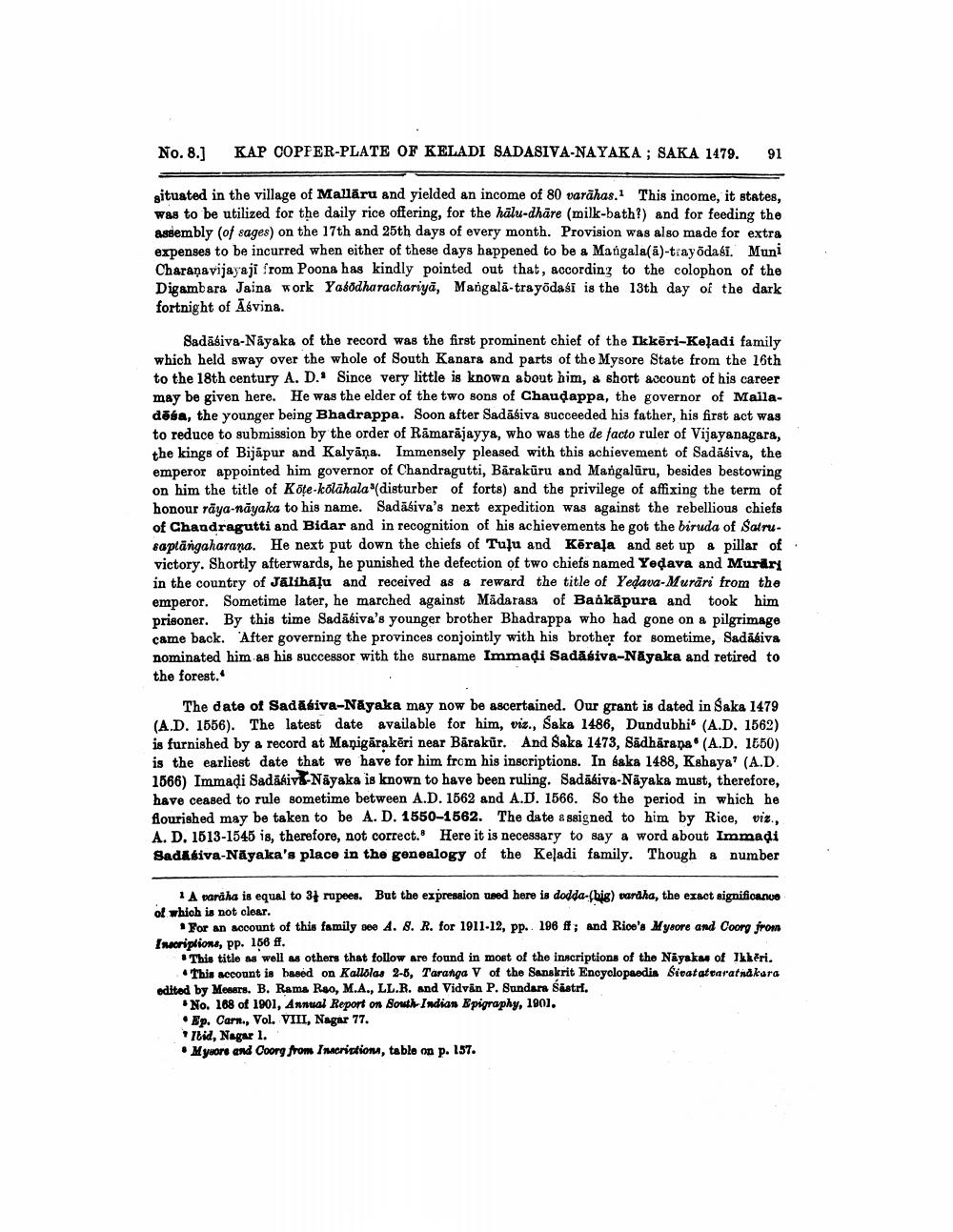________________
No.8.1
KAP COPFER-PLATE OF KELADI SADASIVA-NAYAKA; SAKA 1479.
91
gituated in the village of Malläru and yielded an income of 80 varāhas. This income, it states, was to be utilized for the daily rice offering, for the hālu-dhāre (milk-bath?) and for feeding the assembly of sages) on the 17th and 25th days of every month. Provision was also made for extra expenses to be incurred when either of these days happened to be a Mangala(a)-trayodasi. Muni Charanavijayaji from Poona has kindly pointed out that, according to the colophon of the Digambara Jaina work Yasodharachariya, Mangalā-trayodasi is the 13th day of the dark fortnight of Asvins.
Sadāsiva-Nayaka of the record was the first prominent chief of the Ikkēri-Keladi family which held gway over the whole of South Kanara and parts of the Mysore State from the 16th to the 18th century A. D.' Since very little is known about him, & short account of his career may be given here. He was the elder of the two sons of Chaudappa, the governor of Mailadāśa, the younger being Bhadrappa. Soon after Sadāsiva succeeded his father, his first act was to reduce to submission by the order of Rāmarājayya, who was the de facto ruler of Vijayanagara, the kings of Bijapur and Kalyāna. Immensely pleased with this achievement of Sadāśiva, the emperor appointed him governor of Chandragutti, Bārakūru and Mangaluru, besides bestowing on him the title of Köte-kolāhala (disturber of forts) and the privilege of affixing the term of honour rāya-nāyaka to his name. Sadāśiva's next expedition was against the rebellious chiefs of Chandragutti and Bidar and in recognition of his achievements he got the biruda of Satrusaptangaharana. He next put down the chiefs of Tuļu and Kērala and set up & pillar of victory. Shortly afterwards, he punished the defection of two chiefs named Yedava and Murdry in the country of Jālihāļu and received as & reward the title of Yedava-Murari from the emperor. Sometime later, he marched against Mädarasa of Bankäpura and took him prisoner. By this time Sadāsiva's younger brother Bhadrappa who had gone on a pilgrimage came back. After governing the provinces conjointly with his brother for sometime, Sadāsiva nominated him as his successor with the surname Immadi Sadāśiva-Nāyaka and retired to the forest.
The date of Sadasiva-Nayaka may now be ascertained. Our grant is dated in Saka 1479 (A.D. 1656). The latest date available for him, viz., Saka 1486, Dundubhis (A.D. 1562) is furnished by a record at Manigărakēri near Bärakür. And Saka 1473, Sadhāraņa (A.D. 1650) is the earliest date that we have for him from his inscriptions. In baka 1488, Kshaya? (A.D. 1666) Immadi Sadāsiv-Nayaka is known to have been ruling. Sadāsiva-Nāyaka must, therefore, have ceased to rule sometime between A.D. 1562 and A.D. 1566. So the period in which he flourished may be taken to be A. D. 1550-1562. The date & ssigned to him by Rice, viz., A. D. 1513-1545 is, therefore, not correct. Here it is necessary to say a word about Immadi Sadasiva-Nāyaka's place in the genealogy of the Keladi family. Though & number
* A baráha is equal to 31 rupees. But the expression used here is dodda-(hig) vardha, the exact significance of which is not clear.
*For an account of this family see A. 8. R. for 1911-12, pp. 196 ff; and Rice's Mysore and Coorg from Inscriptions, pp. 156 ff.
This title as well as others that follow are found in most of the inscriptions of the Nāyakau of Ikkeri.
This account is based on Kallolas 2-5, Taranga V of the Sanskrit Encyclopaedis Sivatattarat nakara edited by Messrs. B. Rama Rao, M.A., LL.R. and Vidvin P. Sundara Sastri.
No. 168 of 1901, Annual Report on South Indian Epigraphy, 1901. • Ep. Carn., Vol. VIII, Nagar 77. Ibid, Nagar 1. Mysore and Coorg from Inacriction, table on p. 137.




